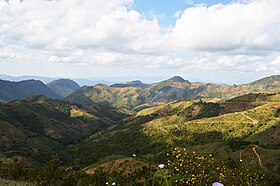Shan Plateau
| Shan Hills | |
|---|---|
| ရှမ်းရိုးမ / ฉานโยมา | |

View of the Shan Hills in southern Shan State
|
|
| Highest point | |
| Peak | Loi Leng |
| Elevation | 2,673 m (8,770 ft) |
| Coordinates | 22°39′N 98°4′E / 22.650°N 98.067°E |
| Dimensions | |
| Length | 560 km (350 mi) N/S |
| Width | 330 km (210 mi) E/W |
| Geography | |
| Countries | Myanmar and Thailand |
| Region | Southeast Asia |
| Range coordinates | 21°30′N 98°00′E / 21.500°N 98.000°ECoordinates: 21°30′N 98°00′E / 21.500°N 98.000°E |
| Parent range | Indo-Malayan System |
| Geology | |
| Type of rock | Granite, limestone |
The Shan Hills (Burmese: ရှမ်းရိုးမ, Thai: ฉานโยมา; Shan Yoma), also known as Shan Highland, is a vast mountainous zone that extends through Yunnan to Myanmar and Thailand. The whole region is made up of numerous mountain ranges separated mostly by narrow valleys as well as a few broader intermontane basins. The ranges in the area are aligned in such a way that they link to the foothills of the Himalayas further to the northwest.
The highest point is Loi Leng, at 2,673 m high. Other peaks are 2,565 m Mong Ling Shan, 2,565 m Doi Inthanon and 2,563 m Loi Pangnao. All are ultra prominent peaks of Southeast Asia.
The name of the massif or system of ranges, is derived from the Shan State and its peoples, said in its turn to be derived from the word "Siam", that occupies most of the Shan Highland area.
Since it was relatively unexplored until recent times, the Shan mountainous region was referred to as the "Shan Plateau" in geographic works of the British colonial period, a name that is still sometimes used. However, since the whole area lacks the expanses of relatively flat high terrain which are the main characteristic of a plateau, this label is rather incongruous.
Geologically in the Shan Hills and their southern subranges, layers of alluvium are superimposed on hard rock.Karstic ranges are common, for large tracts of the hills are limestone. The Shan Hills are an important silver and ruby mining area.
...
Wikipedia

